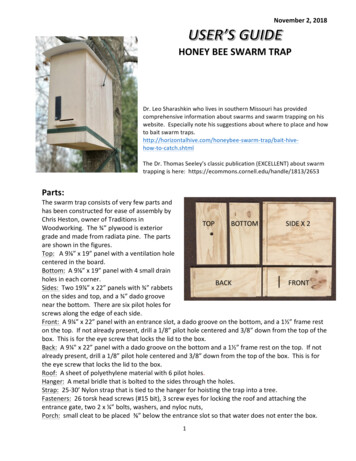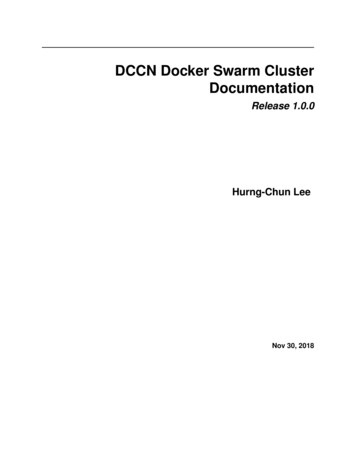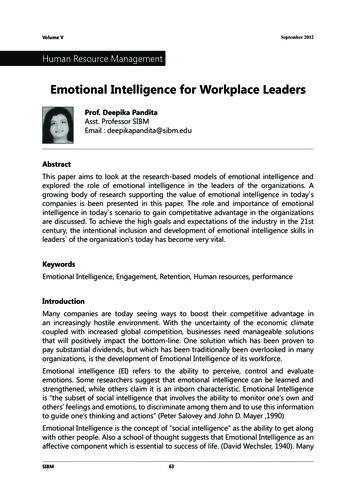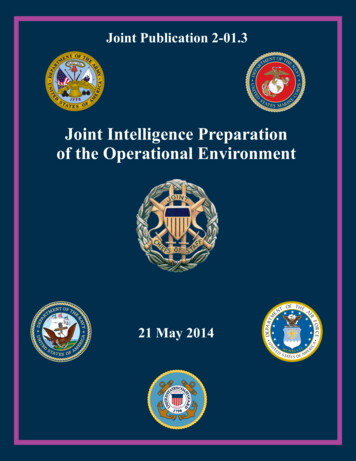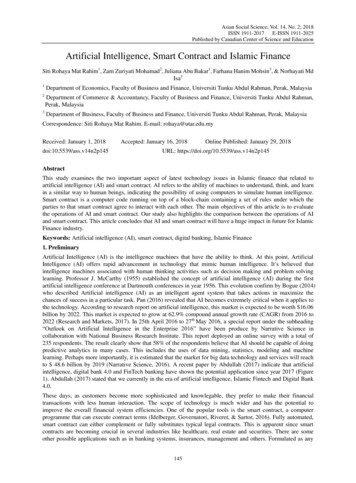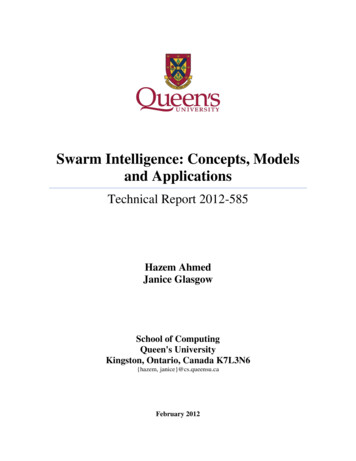
Transcription
Swarm Intelligence: Concepts, Modelsand ApplicationsTechnical Report 2012-585Hazem AhmedJanice GlasgowSchool of ComputingQueen's UniversityKingston, Ontario, Canada K7L3N6{hazem, janice}@cs.queensu.caFebruary 2012
Report Index1.Introduction . 22.Swarm Intelligence (SI) Models . 42.1 Ant Colony Optimization (ACO) Model . 42.1.1 Ants in Nature. 42.1.1.1 Ants Stigmergic behaviour . 42.1.1.2 The Double Bridge Experiment . 52.1.1.3 Real Ants vs. Artificial Ants. 82.1.2 Ant Colony Optimization Metaheuristic . 92.1.2.1 ACO Example: Traveling Salesman Problem and Ant System .122.1.2.2 ACO Variations: Ant System and its Extensions .142.1.2.3 ACO Discussion .152.2 Particle Swarm Optimization (PSO) Model . 162.2.1 Birds in Nature . 162.2.1.1 Birds Flocking Behaviour .162.2.1.2 Birds‘ Physical Movement vs. Humans‘ Psychological Change .182.2.2 Particle Swarm Optimization Metaheuristic. 182.2.2.1 The Original PSO Algorithm .192.2.2.2 The Refinements and Extensions to the Original PSO .222.2.2.3 PSO Discussion .273.SI Applications . 313.1 ACO Applications . 313.1.1 ACO Relevance to Bioinformatics . 323.2 PSO Applications . 323.2.1 PSO Relevance to Bioinformatics . 334.Summary and Concluding Remarks . 344.1 SI General Advantages . 344.2 SI General Limitations . 344.3 Comparison between the two discussed SI Models: ACO vs. PSO . 354.4 Other SI Models . 364.5 Concluding Remarks and Open Questions . 37References . 391
1.IntroductionA swarm is a large number of homogenous, simple agents interacting locallyamong themselves, and their environment, with no central control to allow a globalinteresting behaviour to emerge. Swarm-based algorithms have recently emerged as afamily of nature-inspired, population-based algorithms that are capable of producing lowcost, fast, and robust solutions to several complex problems [1] [2]. Swarm Intelligence(SI) can therefore be defined as a relatively new branch of Artificial Intelligence that isused to model the collective behaviour of social swarms in nature, such as ant colonies,honey bees, and bird flocks. Although these agents (insects or swarm individuals) arerelatively unsophisticated with limited capabilities on their own, they are interactingtogether with certain behavioural patterns to cooperatively achieve tasks necessary fortheir survival. The social interactions among swarm individuals can be either direct orindirect [3]. Examples of direct interaction are through visual or audio contact, such asthe waggle dance of honey bees. Indirect interaction occurs when one individual changesthe environment and the other individuals respond to the new environment, such as thepheromone trails of ants that they deposit on their way to search for food sources. Thisindirect type of interaction is referred to as stigmergy, which essentially meanscommunication through the environment [4]. The area of research presented in this depthpaper focuses on Swarm Intelligence. More specifically, this paper discusses two of themost popular models of swarm intelligence inspired by ants‘ stigmergic behaviour andbirds‘ flocking behaviour.In the past decades, biologists and natural scientists have been studying thebehaviours of social insects because of the amazing efficiency of these natural swarmsystems. In the late-80s, computer scientists proposed the scientific insights of thesenatural swarm systems to the field of Artificial Intelligence. In 1989, the expression"Swarm Intelligence" was first introduced by G. Beni and J. Wang in the globaloptimization framework as a set of algorithms for controlling robotic swarm [5]. In 1991,Ant Colony Optimization (ACO) [6] [7] [8] was introduced by M. Dorigo and colleaguesas a novel nature-inspired metaheuristic for the solution of hard combinatorialoptimization (CO) problems. In 1995, particle swarm optimization was introduced by J.Kennedy et al. [9] [10], and was first intended for simulating the bird flocking socialbehaviour. By the late-90s, these two most popular swarm intelligence algorithms startedto go beyond a pure scientific interest and to enter the realm of real-world applications. Itis perhaps worth mentioning here that a number of years later, exactly in 2005, ArtificialBee Colony Algorithm was proposed by D. Karabago as a new member of the family ofswarm intelligence algorithms [11] [12].Since the computational modeling of swarms was proposed, there has been asteady increase in the number of research papers reporting the successful application of2
Swarm Intelligence algorithms in several optimization tasks and research problems.Swarm Intelligence principles have been successfully applied in a variety of problemdomains including function optimization problems, finding optimal routes, scheduling,structural optimization, and image and data analysis [13] [14]. Computational modeling ofswarms has been further applied to a wide-range of diverse domains, including machinelearning [15], bioinformatics and medical informatics [16], dynamical systems andoperations research [17]; they have been even applied in finance and business [18].The remainder of this paper is organized as follows: The next section presents anoverview of two natural swarm systems (ant colonies and bird flocks), and also discussesand evaluates the two most popular swarm intelligence algorithms inspired by thesenatural swarms, namely, artificial ant colony optimization and particle swarmoptimization. It further compares them with two of the most popular machine learningalgorithms: Artificial Neural Networks and Genetic Algorithms. Then, a summary of thewide-range applications of swarm intelligence algorithms is presented in many differentproblem domains. The last section summarizes the advantages and limitations of swarmintelligence and provides some concluding remarks on the paper and open questions ofthe field.3
2.Swarm Intelligence (SI) ModelsSwarm intelligence models are referred to as computational models inspired bynatural swarm systems. To date, several swarm intelligence models based on differentnatural swarm systems have been proposed in the literature, and successfully applied inmany real-life applications. Examples of swarm intelligence models are: Ant ColonyOptimization [29], Particle Swarm Optimization [9], Artificial Bee Colony [11], BacterialForaging [19], Cat Swarm Optimization [20], Artificial Immune System [21], andGlowworm Swarm Optimization [22]. In this paper, we will primarily focus on two of themost popular swarm intelligences models, namely, Ant Colony Optimization and ParticleSwarm Optimization.2.1 Ant Colony Optimization (ACO) ModelThe first example of a successful swarm intelligence model is Ant ColonyOptimization (ACO), which was introduced by M. Dorigo et al. [6] [7] [8], and has beenoriginally used to solve discrete optimization problems in the late 1980s. ACO drawsinspiration from the social behaviour of ant colonies. It is a natural observation that agroup of ‘almost blind’ ants can jointly figure out the shortest route between their foodand their nest without any visual information. The following section presents somedetails about ants in nature, and shows how these relatively unsophisticated insects cancooperatively interact together to perform complex tasks necessary for their survival.2.1.1 Ants in NatureSince tens of millions of years ago, ants have survived different environments,climates and ages that dinosaurs, for example, did not. The secret of the remarkableecological success of ants can be explained by a single word: sociality [23]. Ants havedemonstrated exceptional social organization in several ways: They are inclined to live inorganized societies made up of individuals that cooperate, communicate, and divide dailytasks. Ants have impressive abilities in finding their way, building their nests, andlocating food supplies. They are not only efficient, but hard-working and thrifty creaturesthat can adapt to different ecosystems and survive harsh weather conditions.2.1.1.1 Ants Stigmergic behaviourAnts, like many other social insects, communicate with each other using volatilechemical substances known as pheromones, whose direction and intensity can beperceived with their long, mobile antennae [24]. The term "pheromone" was firstintroduced by P. Karlson and M. Lüscher in 1959, based on the Greek word pherein(means to transport) and hormone (means to stimulate) [25]. There are different types ofpheromones used by social insects. One example of pheromone types is alarm pheromone4
that crushed ants produce as an alert to nearby ants to fight or escape dangerous predatorsand to protect their colony [26]. Another important type of pheromone is food trailpheromone. Unlike flies, most ants live on the ground and make use of the soil surface toleave pheromone trails, which can be followed by other ants on their way to search forfood sources. Ants that happened to pick the shortest route to food will be the fastest toreturn to the nest, and will reinforce this shortest route by depositing food trailpheromone on their way back to the nest. This route will gradually attract other ants tofollow, and as more ants follow the route, it becomes more attractive to other ants asshown in Figure 1. This autocatalytic or positive feedback process is an example of a selforganizing behaviour of ants in which the probability of an ant‘s choosing a routeincreases as the count of ants that already passed by that route increases.Figure 1: Ants‘ stigmergic behaviour in finding the shortest route between food and nest [49].When the food source is exhausted, no new food pheromone trails are marked byreturning ants and the volatile pheromone scent slowly evaporates. This negativefeedback behaviour helps ants deal with changes in their environment. For instance, whenan already established path to a food source is blocked by an obstacle, the ants leave thepath to explore new routes. Such trail-laying, trail-following behaviour is calledstigmergy (interaction through the environment), and can be considered as an indirecttype of communication in which ants change the environment (soil surface) and the otherants detect and respond to the new environment. Stigmergy provides a generalmechanism that relates individual (local) and colony-level (global) behaviours: individualbehaviour modifies the environment (trail-laying), which in turn modifies the behaviourof other individuals (trail-following) [27].2.1.1.2 The Double Bridge ExperimentThe pheromone trail-laying and trail-following behaviour of ants has been studiedin controlled experiments by several researchers. One simple, yet brilliant experiment isreferred to as the double bridge experiment, which was designed and run by Goss,Deneubourg and colleagues in the late 1980s [28]. The experiment was simply made of adouble bridge connecting a nest of ants and a food source as shown in Figure 2(a).Goss et al. considered different versions of the experimental setup over multipleexperiment runs. In one version, the longer branch of the double bridge was twice as longas the short one and both branches are presented from the beginning of the experiment as5
shown in Figure 2(a)(i). It was noted in this version that most ant traffic (80-100%) waseventually concentrated on the short branch in more than 90% of the experiment runs asshown in Figure 2(b)(i). Initially, ants left the nest to explore the environment; once theyarrived at a decision point, they have to choose one of the two branches. Because the twounmarked branches initially looked identical to the ants (on individual-level behaviour),they were chosen randomly. However, quite surprising at first, the ants (on colony-levelbehaviour) appeared intelligent enough to eventually choose the shorter branch. This isbecause the lucky ants that happened to choose the short branch are the first to reach thefood and to start their return to the nest. On their return way to the nest, these ants will bebiased to pick the short branch over again (now probabilistically and not randomly),because of the higher level of pheromone they already left on the short branch. Returningants will deposit pheromones once more on the short branch, which causes a fasteraccumulation of the pheromone trails on the short branch as opposed to the lower-level ofpheromone on the not-yet-completed long branch. This stimulates more ants to choosethe short branch until eventually it will be adopted by the majority of the ant colony. Thisexplains the positive feedback process of ants, which is based on this simple, selfreinforcement rule: the more number of ants on a branch determines a greater amount of(i)(ii)Figure 2: (a) In the first version of the experimental setup on Left (i), short and long branches are presentedfrom the beginning of the experiment. In the second version of the experimental setup on right (ii), the shortbranch is presented to the colony 30 minutes after the long branch. (b) Distribution of the percentage of antsthat selected the shorter branch over n experiments (r is the length ratio between the two branches). In bothversions, the long branch was twice as long as the short branch. Adapted from Goss et al. [28].6
pheromone, which influences even more ants to choose this branch [23]. Although theshort branch dominated most ant traffic in an impressive path-exploitation behaviour ofants, it can be observed, however, from Figure 2(b)(i) that there is still a small percentageof ant traffic that took the longer branch. This may be interpreted as a type of pathexploration behaviour of ants [29].In another version of the experimental setup, initially only the long branch waspresented to the colony, and then when a stable pheromone trail has formed on theinitially only available long branch, the short branch was offered after 30 minutes, asshown in Figure 2(a)(ii). It is worth mentioning in this version that the longer branch waskept twice as long as the later-offered short branch. This version is deigned to examinewhat happens when the ant colony is offered, after convergence, a new better (i.e.,shorter) path between the nest and the food. It was observed that the short branch was notfrequently selected (e.g., only 0-20% of ant traffic took the newly-offered short branch inalmost 50% of the experiment runs), and thus the colony largely remained trapped on theinitially only-offered long branch as shown in Figure 2(b)(ii). The fact that the greatmajority of ants continued to choose the long branch can be explained by two reasons:The high pheromone concentration on the long branch and the slow evaporation ofpheromone. Firstly, the high-level pheromone concentration of the already establishedtrail on the long branch (compared to the zero-level pheromone-trail concentration on theshort branch) led to an autocatalytic behaviour that continued to reinforce the longbranch, even after a shorter one is offered. Secondly, the very slow rate of pheromoneevaporation did not allow the ant colony to forget the suboptimal path to which theyinitially converged, preventing the new and shorter path to be discovered andlearned [29]. In fact, the pheromone trails of most ant species were usually observed to bepersistent for a long time-scale, ranging from at least several hours up to several months(depending on the ant species, the colony size, weather conditions, etc.) [27].One of the lessons that can be learned from this experiment is that the pheromoneevaporation rate is a key parameter in the convergence process, because it controls thetrade-off between path-exploration of new (and hopefully better) paths and pathexploitation of the already established path. Therefore, in the field of artificial ant colonyoptimization, it is a common practice to set the pheromone evaporation to a sufficientlyshort time-scale [28]. This allows artificial ant colonies to favour the forgetting of errors(or bad choices) done in the past to allow a continuous improvement of the learnedproblem [29]. It also helps artificial ant colonies to avoid being trapped on a suboptimalsolution and to reduce the risk of possibly stucking in local optima – one of the majorconcerns of optimization problems. In fact, the pheromone evaporation rate is aninteresting example where there is a clear difference between real and artificial ants. Thenext section discusses the other differences between real and artificial ants, and illustratesthe general framework used to move from a natural phenomenon to an artificial system.7
2.1.1.3 Real Ants vs. Artificial AntsUnderstanding a natural phenomenon and designing a nature-inspired algorithmare two related, yet different tasks. Understanding a natural phenomenon is constrainedby observations and experiments, while designing a nature-inspired algorithm is onlylimited by one's imagination and available technology. Although the underlyingprinciples of ant colony optimization metaheuristic are inspired by the social behaviour ofant colonies, some characteristics of artificial ants do not have to be identically the sameas real ants. Table 1 summarizes the main differences between artificial ants and real ants.The artificial ant colony optimization metaheuristic just models the natural ant behaviour.Modeling serves as an interface between understanding nature and designing artificialsystems. In other words, one starts from the observed natural phenomenon, tries to makea nature-inspired model of it, and then design an artificial system after exploring themodel without constraints [27]. Figure 3 illustrates the framework that is generally used tomove from a natural phenomenon to a nature-inspired algorithm. It is worth emphasizingthat ―memory‖ is the key difference between real and artificial ants; real ants have nomemory, while artificial ants are offered a limited form of memory. The use of memoryhelps artificial ants to implement a number of useful behaviours that allow them toefficiently build solutions for more complex optimization problems than the simpledouble bridge experiment. One of such useful behaviours is that artificial antsevaluate the quality of the solutions generated, and use the solution quality in determiningCriteriaReal AntsArtificial AntsPheromoneDepositingBehaviourPheromone is deposited bothways while ants are moving (i.e.on their forward and return ways).The pheromone trail on a path isupdated, in some ant species,with a pheromone amount thatdepends on the quantity andquality of the food [31].Pheromone is often deposited only on thereturn way after a candidate solution isconstructed and evaluated.Once an ant has constructed a path, thepheromone trail of that path is updated onits return way with an amount that isinversely proportional to the path lengthstored in its memory.Artificial ants store the paths they walkedonto in their memory to be used inretracing the return path. They also use itslength in determining the quantity ofpheromone to deposit on their return way.Since no pheromone is deposited on theforward path, artificial ants use the storedpaths from their memory to retrace theirreturn way.Pheromone evaporates exponentiallymaking it more significant for litiesReturn alConstraintsReal ants have no memorycapabilities.Real ants use the pheromonedeposited on their forward path toretrace their return way whenthey head back to their nestPheromone evaporates too slowlymaking it less significant for theconvergence.Exist, such as predation orcompetition with other coloniesand the colony's level ofprotection.Ecological constraints do not exist in theartificial/virtual world.Table 1: Differences between Real Ants and Artificial Ants8
the quantity of pheromone to deposit. That is why pheromone is deposited only on thereturn way after a full path (or, a candidate solution) is constructed and evaluated in termsof the path length (or, generally, the solution cost).Figure 3: An illustration to the general framework used to move from a natural phenomenon to a nature-inspired algorithm. First, nature inspires humans to develop an observation of a particular naturalphenomenon. Next, they create a model and test it using mathematical simulations, which help to refinethe original model. Then, the refined model will be used to extract a metaheuristic that can be used as abasis to finally design and tune a nature-inspired algorithm.2.1.2 Ant Colony Optimization MetaheuristicACO is based on pheromone laying/pheromone following behaviour of real antsthat helps find the shortest route between their nest and a food source. ACO has beenused to solve many optimization problems such as sequential ordering [32],scheduling [33], assembly line balancing [34], probabilistic Traveling Salesman Problem(TSP) [35], DNA sequencing [36], 2D-HP protein folding [37], and protein–liganddocking [38]. The main idea is to model the problem to be solved as a search for anoptimal path in a weighted graph, called construction graph, and to use artificial ants tosearch for quality paths. A construction graph is a graph on which artificial antsiteratively deposit pheromone trails to help choose the graph nodes of quality paths thatcorrespond to solution components. The behaviour of artificial ants simulates thebehaviour of real ones in several ways: (i) artificial ants deposit pheromone trails on thenodes of quality paths to reinforce the most promising solution components of theconstruction graph, (ii) artificial ants construct solutions by moving through the9
construction graph and choose their path with respect to probabilities, which depend onthe pheromone trails previously deposited, and (iii) artificial pheromone trails decreasesufficiently quickly at each iteration simulating the slowly-evaporative pheromone trailphenomena observed in real ants [39]. A key point in the development of any ACOalgorithm is to decide the fitness function based on which the components of a problem‘sconstruction graph will be rewarded with a high-level pheromone trail, and to determinehow ants will exploit these promising components when constructing new solutions. Thefitness function of ACO is often implicitly formulated as cost minimization of solutioncomponents, i.e., the goal of artificial ants is to walk on the construction graph and selectthe nodes that minimize the overall cost of the solution path.Algorithm 1: Basic flow of ACO (adapted from [29])1. Represent the solution space by a construction graph.2. Set ACO parameters and initialize pheromone trails3. Generate ant solutions from each ant‘s walk on the construction graph mediated bypheromone trails.4. Update pheromone intensities.5. Go to step 3, and repeat until convergence or termination conditions are met.As shown in the basic flow of ACO above, the objective of ACO‘s third step is toconstruct ant solutions (i.e., find the quality paths on the problem‘s construction graph)by stochastically moving through neighbour nodes of the graph. Ants are driven by aprobability rule to sequentially choose the solution components that make use ofpheromone trail intensities and heuristic information. The solution of each ant isconstructed when all solution components are selected by that ant (i.e., when the ant hascompleted a full tour/path on the construction graph). Once an ant has constructed asolution, or while the solution is being constructed, the ant evaluates the full (or partial)solution to be used by the ACO‘s next step (the pheromone updating step) in determininghow much pheromone to deposit. The probability rule (equation 1) is called RandomProportional Action Choice rule (or State Transition rule). It guides ant movementthrough a stochastic local decision policy that essentially depends on both pheromoneinformation and heuristic information [40].( )( ){ ( )( )Where: ( ) is the probability of the kth ant to move from node i to node j at the tthiteration/time step. is the set of nodes in the neighborhood of the kth ant in the ith node.10
( ) 0, means the ants are not allowed to move to any node notin their neighborhood. The neighborhood definition is problem-specific, forexample, in the Traveling Salesman Problem (as discussed later inSection 2.1.2.1) the neighborhood is defined by the adjacent cities in the allowedlist (the allowed list contains all unvisited cities), while in the ImageSegmentation problem, the neighborhood can be defined as the 8-connectedpixels surrounding each pixel on a two-dimensional square lattice.( ) is the pheromone amount on the arc connecting node i and node j,weighted by(an application-depend constant).( ) isthe pheromoneinformation, or trail intensity value, that encodes a long-term memory about thewhole ant search process. It is updated by all ants after each iteration t(sometimes, however, in more recent ACO versions it is updated by only someants – the best one(s) that constructed the iteration-best or best-so-far solution). is the heuristic value of the arc connecting node i and node j, weightedby(an application-depend constant).is the heuristic information, or pathvisibility, that represents a priori information about the problem instancedefinition, or run-time information provided by a different source other than ants.The heuristic valueis usually a non-increasing function in the moving costfrom node i to node j, and it often does not change during algorithm executionunless the moving cost is not static. andare weight parameters that control the relative importance of thepheromone versus heuristic information.o A high value for α means that pheromone information is very important;thus, ants are strongly biased to choose nodes previously chosen by otherants. This potentially leads to a stagnation situation in which all the antswould eventually follow the same path (usually suboptimal) and constructthe same tour [29].o A low value of α makes the algorithm very similar to a stochastic multigreedy algorithm with m starting points, as there is m number of ants thatare initially randomly distributed over the construction graph.o When α 0, the ACO performs a typical stochastic greedy search strategyin which the next node (problem state) is selected only on the basis of itsdistance (cost) from the current node/state. As a result, the node with theminimum cost will be always favoured regardless of how many other antshave visited it, and how much its pheromone intensity is [29].11
o When β 0, the pheromone information is only used to guide the searchprocess, which would reflect the way that ants do in real world (real antsdo not use any heuristic information in their search process) [41].The objective of ACO‘s fourth step is to update pheromone trails. At the verybeginning, the pheromone trails of all arcs on the construction graph are initialized to asmall constant value ( ). Then after a tour (or, a solution path) is constructed, thepheromone trails are updated in two ways, as shown in equations 2 and 3. Firstly, thepheromone trails of all arcs are decreased according to an evaporation rate (ρ) that allowsants to forget the suboptimal paths to which they previously converged. Pheromoneevaporation rate is usually set to be
Swarm intelligence models are referred to as computational models inspired by natural swarm systems. To date, several swarm intelligence models based on different natural swarm systems have been proposed in the literature, and successfully applied in many real-life applications. Examples of swarm intelligence models are: Ant Colony

